The Recent Progress of Pitch Nanoengineering to Obtain the Carbon Anode for High-Performance Sodium Ion Batteries
Abstract
1. Introduction
2. Nanoengineering of Pitch for High-Performance SIB Carbon Anode
2.1. Porous Structure Adjustment
2.2. Heteroatom Doping
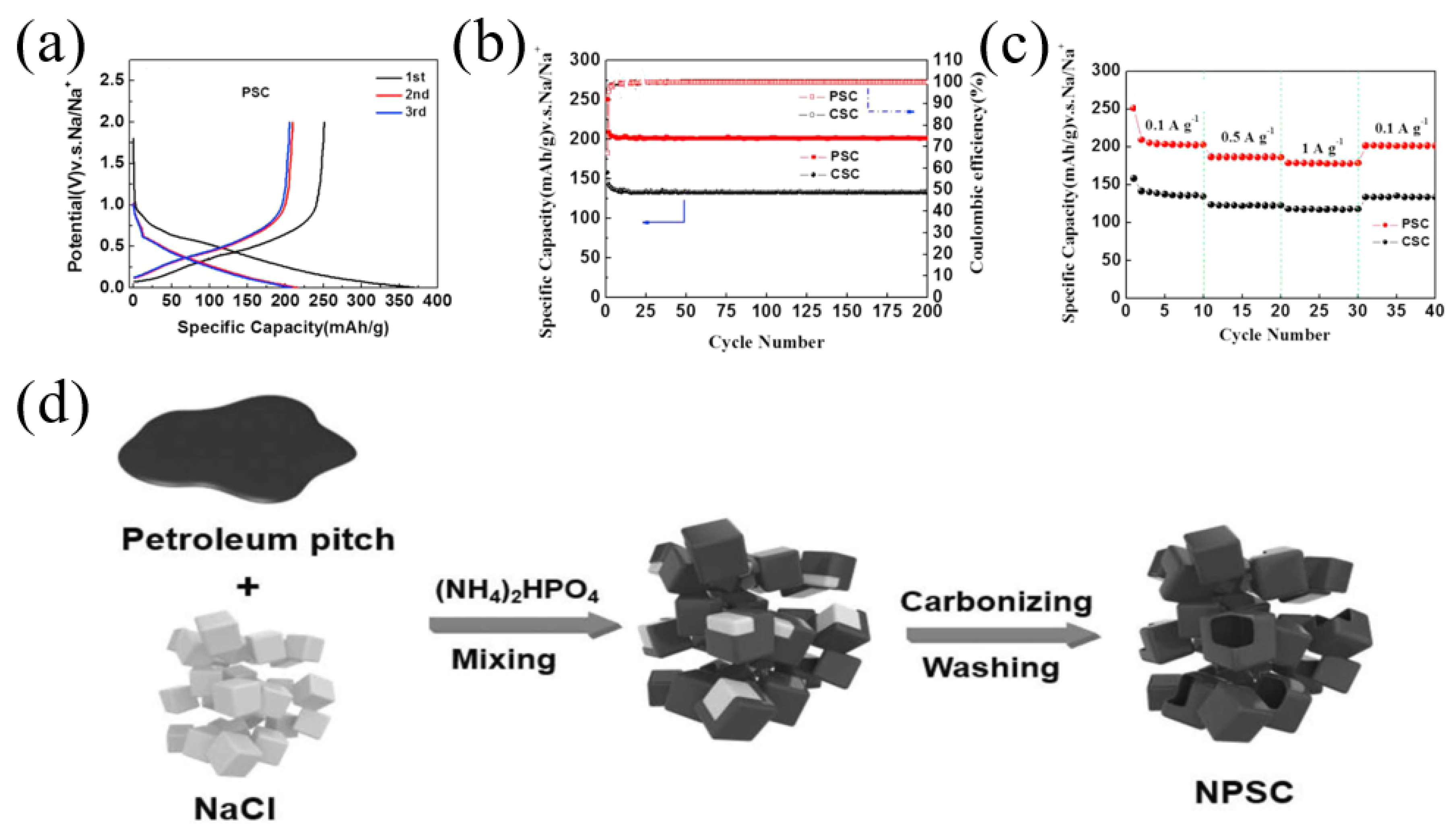

2.3. Co-Carbonization
2.4. Pre-Oxidation
3. Challenges and Perspectives
4. Conclusions
Funding
Conflicts of Interest
References
- Pu, X.; Wang, H.; Zhao, D.; Yang, H.; Ai, X.; Cao, S.; Chen, Z.; Cao, Y. Recent progress in rechargeable sodium-ion batteries: Toward high-power applications. Small 2019, 15, 1805427. [Google Scholar] [CrossRef]
- Xin, S.; Guo, Y.G.; Wan, L.J. Nanocarbon networks for advanced rechargeable lithium batteries. Acc. Chem. Res. 2012, 45, 759–1769. [Google Scholar] [CrossRef] [PubMed]
- Fang, Y.; Yu, X.Y.; Lou, X.W.D. Nanostructured electrode materials for advanced sodium-ion batteries. Matter 2019, 1, 90–114. [Google Scholar] [CrossRef]
- Pan, H.; Hu, Y.S.; Chen, L. Room-temperature stationary sodium-ion batteries for large-scale electric energy storage. Energy Environ. Sci. 2013, 6, 2338–2360. [Google Scholar] [CrossRef]
- Ma, P.; Fang, D.; Liu, Y.; Shang, Y.; Yang, H.Y. MXene-Based Materials for Electrochemical Sodium-Ion Storage. Adv. Sci. 2021, 8, 2003185. [Google Scholar] [CrossRef]
- Ong, S.P.; Chevrier, V.L.; Hautier, G.; Jain, A.; Moore, C.; Kim, S.; Ma, X.; Ceder, G. Voltage, stability and diffusion barrier differences between sodium-ion and lithium-ion intercalation materials. Energy Environ. Sci. 2011, 4, 3680–3688. [Google Scholar] [CrossRef]
- He, L.; Sun, Y.R.; Wang, C.L.; Guo, H.Y.; Guo, Y.Q.; Li, C.; Zhou, Y. High performance sulphur-doped pitch-based carbon materials as anode materials for sodium-ion batteries. New Carbon Mater. 2020, 35, 420–427. [Google Scholar] [CrossRef]
- Kozlovskiy, A.L.; Zdorovets, M.V. Effect of doping of Ce4+/3+ on optical, strength and shielding properties of (0.5−x) TeO2-0.25 MoO-0.25 Bi2O3-xCeO2 glasses. Mater. Chem. Phys. 2021, 263, 124444. [Google Scholar] [CrossRef]
- Zhang, W.; Zhang, F.; Ming, F.; Alshareef, H.N. Sodium-ion battery anodes: Status and future trends. J. Energy Chem. 2019, 1, 100012. [Google Scholar] [CrossRef]
- Cui, J.; Yao, S.; Huang, J.Q.; Qin, L.; Chong, W.G.; Sadighi, Z.; Huang, J.; Wang, Z.; Kim, J.K. Sb-doped SnO2/graphene-CNT aerogels for high performance Li-ion and Na-ion battery anodes. Energy Storage Mater. 2017, 9, 85–95. [Google Scholar] [CrossRef]
- Sun, N.; Guan, Y.; Liu, Y.T.; Zhu, Q.; Shen, J.; Liu, H.; Zhou, S.; Xu, B. Facile synthesis of free-standing, flexible hard carbon anode for high-performance sodium ion batteries using graphene as a multi-functional binder. Carbon 2018, 137, 475–483. [Google Scholar] [CrossRef]
- Ma, C.; Xu, T.; Wang, Y. Advanced carbon nanostructures for future high performance sodium metal anodes. Energy Storage Mater. 2020, 25, 811–826. [Google Scholar] [CrossRef]
- Zhao, R.; Sun, N.; Xu, B. Recent advances in heterostructured carbon materials as anodes for sodium-ion batteries. Small Struct. 2021, 2, 2100132. [Google Scholar] [CrossRef]
- Zhang, M.; Li, Y.; Wu, F.; Bai, Y.; Wu, C. Boost sodium-ion batteries to commercialization: Strategies to enhance initial Coulombic efficiency of hard carbon anode. Nano Energy 2021, 82, 105738. [Google Scholar] [CrossRef]
- Hou, H.; Qiu, X.; Wei, W.; Yun, Z.; Ji, X. Carbon anode materials for advanced sodium-ion batteries. Adv. Energy Mater. 2017, 7, 1602898. [Google Scholar] [CrossRef]
- Stevens, D.A.; Dahn, J.R. High-capacity anode materials for rechargeable sodium-ion batteries. J. Electrochem. Soc. 2000, 147, 1271. [Google Scholar] [CrossRef]
- Lu, Y.; Zhao, C.; Qi, X.; Qi, Y.; Li, H.; Huang, X.; Chen, L.; Hu, Y.-S. Pre-oxidation-tuned microstructures of carbon anodes derived from pitch for enhancing Na storage performance. Adv. Energy Mater 2018, 8, 1800108. [Google Scholar] [CrossRef]
- Jiang, M.; Sun, N.; Soomro, R.A.; Xu, B. The recent progress of pitch-based carbon anodes in sodium-ion batteries. J. Energy Chem. 2021, 55, 34–47. [Google Scholar] [CrossRef]
- Xue, Y.C.; Gao, M.Y.; Wu, M.G.; Su, D.Q.; Shi, J.; Duan, M.T.; Chen, J.L.; Zhang, J.H. A promising hard carbon–soft carbon composite anode with boosting sodium storage performance. ChemElectroChem 2020, 7, 4010–4015. [Google Scholar] [CrossRef]
- Sarkar, S.; Roy, S.; Hou, Y.L.; Sun, S.H.; Zhang, J.J.; Zhao, Y.F. Recent Progress in Amorphous Carbon-Based Materials for Anodes of Sodium-Ion Batteries: Synthesis Strategies, Mechanisms, and Performance. ChemSusChem 2021, 14, 3693–3723. [Google Scholar] [CrossRef]
- Wang, Q.; Zhao, C.; Lu, Y.; Li, Y.; Chen, L. Advanced nanostructured anode materials for sodium-ion batteries. Small 2017, 13, 1701835. [Google Scholar] [CrossRef]
- Ma, C.; Zhao, Y.; Li, J.; Song, Y.; Shi, J.; Guo, Q.; Liu, L. Synthesis and electrochemical properties of artificial graphite as an anode for high-performance lithium-ion batteries. Carbon 2013, 64, 553–556. [Google Scholar] [CrossRef]
- He, X.; Li, X.; Ma, H.; Han, J.; Zhang, H.; Yu, C.; Xiao, N.; Qiu, J. ZnO template strategy for the synthesis of 3D interconnected graphene nanocapsules from coal tar pitch as supercapacitor electrode materials. J. Power Sources 2017, 340, 183–191. [Google Scholar] [CrossRef]
- Zhang, G.; Guan, T.T.; Qiao, J.L.; Wang, J.L.; Li, K.X. Free-radical-initiated strategy aiming for pitch-based dual-doped carbon nanosheets engaged into high-energy asymmetric supercapacitors. Energy Storage Mater. 2020, 26, 119–128. [Google Scholar] [CrossRef]
- Guan, T.T.; Zhang, G.L.; Zhao, J.H.; Wang, J.L.; Li, K.X. Insight into the oxidative reactivity of pitch fractions for predicting and optimizing the oxidation stabilization of pitch. Fuel 2019, 242, 184–194. [Google Scholar] [CrossRef]
- Cao, Y.L.; Xiao, L.F.; Sushko, M.L.; Wang, W.; Schwenzer, B.; Xiao, J.; Nie, Z.M.; Saraf, L.V.; Yang, Z.G.; Liu, J. Sodium ion insertion in hollow carbon nanowires for battery applications. Nano Lett. 2012, 12, 3783–3787. [Google Scholar] [CrossRef]
- Vu, A.; Qian, Y.; Stein, A. Porous electrode materials for lithium-ion batteries-how to prepare them and what makes them special. Adv. Energy Mater. 2012, 2, 1056–1085. [Google Scholar] [CrossRef]
- Wenzel, S.; Hara, T.; Janek, J.; Adelhelm, P. Room-temperature sodium-ion batteries: Improving the rate capability of carbon anode materials by templating strategies. Energy Environ. Sci. 2011, 4, 3342–3345. [Google Scholar] [CrossRef]
- Guan, Z.; Liu, H.; Xu, B.; Wang, Z.X.; Chen, L.Q. Gelatin-pyrolyzed mesoporous carbon as a high-performance sodium-storage material. J. Mater. Chem. A 2015, 3, 7849–7854. [Google Scholar] [CrossRef]
- He, X.; Ma, H.; Wang, J.; Xie, Y.; Xiao, N.; Qiu, J. Porous carbon nanosheets from coal tar for high-performance supercapacitors. J. Power Sources 2017, 357, 41–46. [Google Scholar] [CrossRef]
- Cao, B.; Liu, H.; Xu, B.; Lei, Y.; Song, H. Mesoporous soft carbon as an anode material for sodium ion batteries with superior rate and cycling performance. J. Mater. Chem. A 2016, 4, 6472–6478. [Google Scholar] [CrossRef]
- Peng, L.; Yi, S.; Xiang, H.; Xin, L.; Yan, Y. 3D amorphous carbon with controlled porous and disordered structures as a high-rate anode material for sodium-ion batteries. Adv. Energy Mater. 2018, 8, 1702434. [Google Scholar]
- Qiu, D.; Cao, T.; Zhang, J.; Zhang, S.W.; Zheng, D.; Wu, H.; Wei, L.; Kang, F.; Yang, Q.H. Precise carbon structure control by salt template for high performance sodium-ion storage. J. Energy Chem. 2019, 31, 101–106. [Google Scholar] [CrossRef]
- Su, Q.; Zeng, S.Y.; Tang, M.; Zheng, Z.J.; Wang, Z.B. Flexible carbon nanofibrous membranes with adjustable hierarchical porous structure as high-capacity anodes for sodium-ion batteries. Energy Technol. 2021, 9, 2100049. [Google Scholar] [CrossRef]
- Li, X.S.; Zhao, H.H.; Zhang, C.; Xing, B.L.; Zhang, C.X.; Zhou, C.C. One-pot fabrication of pitch-derived soft carbon with hierarchical porous structure and rich sp2 carbon for sodium-ion battery. J. Mater. Sci. Mater. Electron. 2021, 32, 21944–21956. [Google Scholar] [CrossRef]
- Chen, W.M.; Wan, M.; Liu, Q.; Xiong, X.Q.; Yu, F.Q.; Huang, Y.H. Heteroatom-doped carbon materials: Synthesis, mechanism, and application for sodium-ion batteries. Small Methods 2019, 3, 1800323. [Google Scholar] [CrossRef]
- Shaji, N.; Ho, C.W.; Nanthagopal, M.; Santhoshkumar, P.; Sim, G.S.; Lee, C.W. Biowaste-derived heteroatoms-doped carbon for sustainable sodium-ion storage. J. Alloys Compd. 2021, 872, 159670. [Google Scholar] [CrossRef]
- Liu, H.; Jia, M.Q.; Cao, B.; Chen, R.J.; Lv, X.Y.; Tang, R.J.; Wu, F.; Xu, B. Nitrogen-doped carbon/graphene hybrid anode material for sodium-ion batteries with excellent rate capability. J. Power Sources 2016, 319, 195–201. [Google Scholar] [CrossRef]
- Hu, X.D.; Sun, X.H.; Yoo, S.Y.; Evanko, B.; Fan, F.; Cai, S.; Zheng, C.M.; Hu, W.B.; Stucky, G.D. Nitrogen-rich hierarchically porous carbon as a high-rate anode material with ultra-stable cyclability and high capacity for capacitive sodium-ion batteries. Nano Energy 2019, 56, 828–839. [Google Scholar] [CrossRef]
- Wang, H.G.; Wu, Z.; Meng, F.L.; Ma, D.L.; Huang, X.L.; Wang, L.M.; Zhang, X.B. Nitrogen-doped porous carbon nanosheets as low-cost, high-performance anode material for sodium-ion batteries. HemSusChem 2013, 6, 56–60. [Google Scholar] [CrossRef]
- Hao, M.Y.; Xiao, N.; Wang, Y.W.; Li, H.Q.; Zhou, Y.; Liu, C.; Qiu, J.S. Pitch-derived N-doped porous carbon nanosheets with expanded interlayer distance as high-performance sodium-ion battery anodes. Fuel Process. Technol. 2018, 177, 328–335. [Google Scholar] [CrossRef]
- Xue, H.T.; Sun, Q.; Lu, R.F.; Liu, C. Pyrolysis of coal pitch-infused melamine foam to construct N-doped carbon anodes for high-performance sodium-ion battery. J. Electroanal. Chem. 2021, 902, 115809. [Google Scholar] [CrossRef]
- Kiciński, W.; Szala, M.; Bystrzejewski, M. Sulfur-doped porous carbons: Synthesis and applications. Carbon 2014, 68, 1–32. [Google Scholar] [CrossRef]
- Li, Z.; Cao, Y.J.; Li, G.Y.; Chen, L.; Xu, W.Y.; Zhou, M.J.; He, B.H.; Wang, W.; Hou, Z.H. High-rate capability of S-doped ordered mesoporous carbon materials with directional arrangement of carbon layers and large d-spacing for sodium-ion battery. Electrochim. Acta. 2021, 366, 137466. [Google Scholar] [CrossRef]
- Yang, J.Q.; Zhou, X.L.; Wu, D.H.; Zhao, X.D.; Zhou, Z. S-doped N-rich carbon nanosheets with expanded interlayer distance as anode materials for sodium-ion batteries. Adv. Mater. 2017, 29, 1604108. [Google Scholar] [CrossRef]
- Hou, H.S.; Shao, L.D.; Zhang, Y.; Zou, G.Q.; Chen, J.; Ji, X.B. Large-area carbon nanosheets doped with phosphorus: A high-performance anode material for sodium-ion batteries. Adv. Sci. 2017, 4, 1600243. [Google Scholar] [CrossRef] [PubMed]
- Sun, W.; Sun, Q.; Lu, R.F.; Wen, M.X.; Liu, C.; Xu, J.L.; Wu, Y.X. Sodium hypophosphite-assist pyrolysis of coal pitch to synthesis P-doped carbon nanosheet anode for ultrafast and long-term cycling sodium-ion batteries. J. Alloys Compd. 2021, 889, 61678. [Google Scholar] [CrossRef]
- Miao, Y.L.; Zong, J.; Liu, X.J. Phosphorus-doped pitch-derived soft carbon as an anode material for sodium ion batteries. Mater. Lett. 2017, 188, 355–358. [Google Scholar] [CrossRef]
- Paraknowitsch, J.P.; Thomas, A. Doping carbons beyond nitrogen: An overview of advanced heteroatom doped carbons with boron, sulphur and phosphorus for energy applications. Energy Environ. Sci. 2013, 6, 2839–2855. [Google Scholar] [CrossRef]
- Zhao, Y.; Cong, Y.; Ning, H.; Fei, X.; Wu, C.H.; Wang, H.; He, Z.Q.; Wang, Y.N.; Zhao, Q.S.; Wu, M.B. N, P co-doped pitch derived soft carbon nanoboxes as high-performance anodes for sodium-ion batteries. J. Alloys Compd. 2022, 918, 165691. [Google Scholar] [CrossRef]
- Sun, L.; Song, X.Y.; Liu, Y.X.; Xie, J.; Wu, J.; Cheng, F.; Zhang, X.L.; Tie, Z.X.; Jin, Z. Spongy-like N, S-codoped ultrathin layered carbon assembly for realizing high performance sodium-ion batteries. FlatChem 2021, 28, 100258. [Google Scholar] [CrossRef]
- Xie, F.; Xu, Z.; Jensen, A.C.S.; Au, H.; Lu, Y.S.; Araullo-Peters, V.; Drew, A.J.; Hu, Y.S.; Titirici, M.M. Hard–soft carbon composite anodes with synergistic sodium storage performance. Adv. Funct. Mater. 2019, 29, 1901072. [Google Scholar] [CrossRef]
- Kumar, V.K.; Ghosh, S.; Biswas, S.; Martha, S.K. Pitch-derived soft-carbon-wrapped NaVPO4F composite as a potential cathode material for sodium-ion batteries. ACS Appl. Energy Mater. 2021, 4, 4059–4069. [Google Scholar] [CrossRef]
- Alvin, S.; Chandra, C.; Kim, J. Controlling intercalation sites of hard carbon for enhancing Na and K storage performance. Chem. Eng. J. 2021, 411, 128490. [Google Scholar] [CrossRef]
- Liu, J.C.; Chen, X.J.; Liang, D.C.; Xie, Q. Development of pitch-based carbon fibers: A review. Energy Sources Part A Recovery Util. Environ. Eff. 2020, 1–21. [Google Scholar] [CrossRef]
- Trukhanov, A.V.; Tishkevich, D.I.; Podgornaya, S.V.; Egor, K.; Moustafa, A.D.; Tatiana, I.Z.; Andrey, V.T.; Ekaterina, L.T.; Vladimir, G.K.; Sergei, V.T. Impact of the nanocarbon on magnetic and electrodynamic properties of the ferrite/polymer composites. Nanomaterials 2022, 12, 868. [Google Scholar] [CrossRef]
- Li, Y.M.; Mu, L.Q.; Hu, Y.S.; Li, H.; Chen, L.Q.; Huang, X.J. Pitch-derived amorphous carbon as high performance anode for sodium-ion batteries. Energy Storage Mater. 2016, 2, 139–145. [Google Scholar] [CrossRef]
- Yin, X.P.; Zhao, Y.F.; Wang, X.; Lu, Z.X.; Li, Y.; Long, H.L.; Wang, J.; Ning, J.Y.; Zhang, J.J. Modulating the graphitic domains of hard carbons derived from mixed pitch and resin to achieve high rate and stable sodium storage. Small 2022, 18, 2105568. [Google Scholar] [CrossRef]
- Wang, Y.W.; Xiao, N.; Wang, Z.Y.; Tang, Y.C.; Li, H.Q.; Yu, M.L.; Liu, C.; Zhou, Y.; Qiu, J.S. Ultrastable and high-capacity carbon nanofiber anodes derived from pitch/polyacrylonitrile for flexible sodium-ion batteries. Carbon 2018, 135, 187–194. [Google Scholar] [CrossRef]
- Khan, M.; Tahir, M.N.; Adil, S.F.; Khan, H.U.; Tremel, W. Graphene based metal and metal oxide nanocomposites: Synthesis, properties and their applications. J. Mater. Chem. A 2015, 3, 18753–18808. [Google Scholar] [CrossRef]
- Yang, S.B.; Dong, W.; Shen, D.; Li, S.N.; Sun, W.; Hong, X.D.; Wang, M.; Mao, Y.Q. Composite of nonexpansion reduced graphite oxide and carbon derived from pitch as anodes of Na-ion batteries with high coulombic efficiency. Chem. Eng. J. 2017, 309, 674–681. [Google Scholar] [CrossRef]
- Miura, K.; Nakagawa, H.; Hashimoto, K. Examination of the oxidative stabilization reaction of the pitch-based carbon fiber through continuous measurement of oxygen chemisorption and gas formation rate. Carbon 1995, 33, 275–282. [Google Scholar] [CrossRef]
- Zhang, X.; Song, Y.; Wu, J.; Yang, T.; Liu, Z. Boosting Zn-ion storage capacity of pitch coke-based activated carbon via pre-oxidation assisted KOH activation strategy. Microporous Mesoporous Mater. 2022, 333, 111721. [Google Scholar] [CrossRef]
- Kozlovskiy, A.; Egizbek, K.; Zdorovets, M.V.; Ibragimova, M.; Shumskaya, A.; Rogachev, A.A.; Zhanna, V.I.; Kadyrzhanov, K. Evaluation of the efficiency of detection and capture of manganese in aqueous solutions of FeCeOx nanocomposites doped with Nb2O5. Sensors 2020, 20, 4851. [Google Scholar] [CrossRef]
- Yuan, C.; Zhu, Y.Y.; Zhao, P.Y.; Yu, B.J.; Li, Q.; Wang, P.C.Y. Enhanced Electrochemical Performance of Mesocarbon-Microbeads-Based Anodes through Air Oxidation for Sodium-Ion Batteries. ChemElectroChem 2017, 4, 2583–2592. [Google Scholar] [CrossRef]
- Sun, Y.; Lu, P.; Liang, X.; Chen, C.H.; Xiang, H.F. High-yield microstructure-controlled amorphous carbon anode materials through a pre-oxidation strategy for sodium ion batteries. J. Alloys Compd. 2019, 786, 468–474. [Google Scholar] [CrossRef]
- Daher, N.; Huo, D.; Davoisne, C.; Meunier, P.; Janot, R. Impact of preoxidation treatments on performances of pitch-based hard carbons for sodium-ion batteries. ACS Appl. Energy Mater. 2020, 3, 6501–6510. [Google Scholar] [CrossRef]
- Guo, H.Y.; Li, Y.Y.; Wang, C.L.; He, L.; Li, C.; Guo, Y.Q.; Zhou, Y. Effect of the air oxidation stabilization of pitch on the microstructure and sodium storage of hard carbons. New Carbon Mater. 2021, 36, 1073–1078. [Google Scholar] [CrossRef]
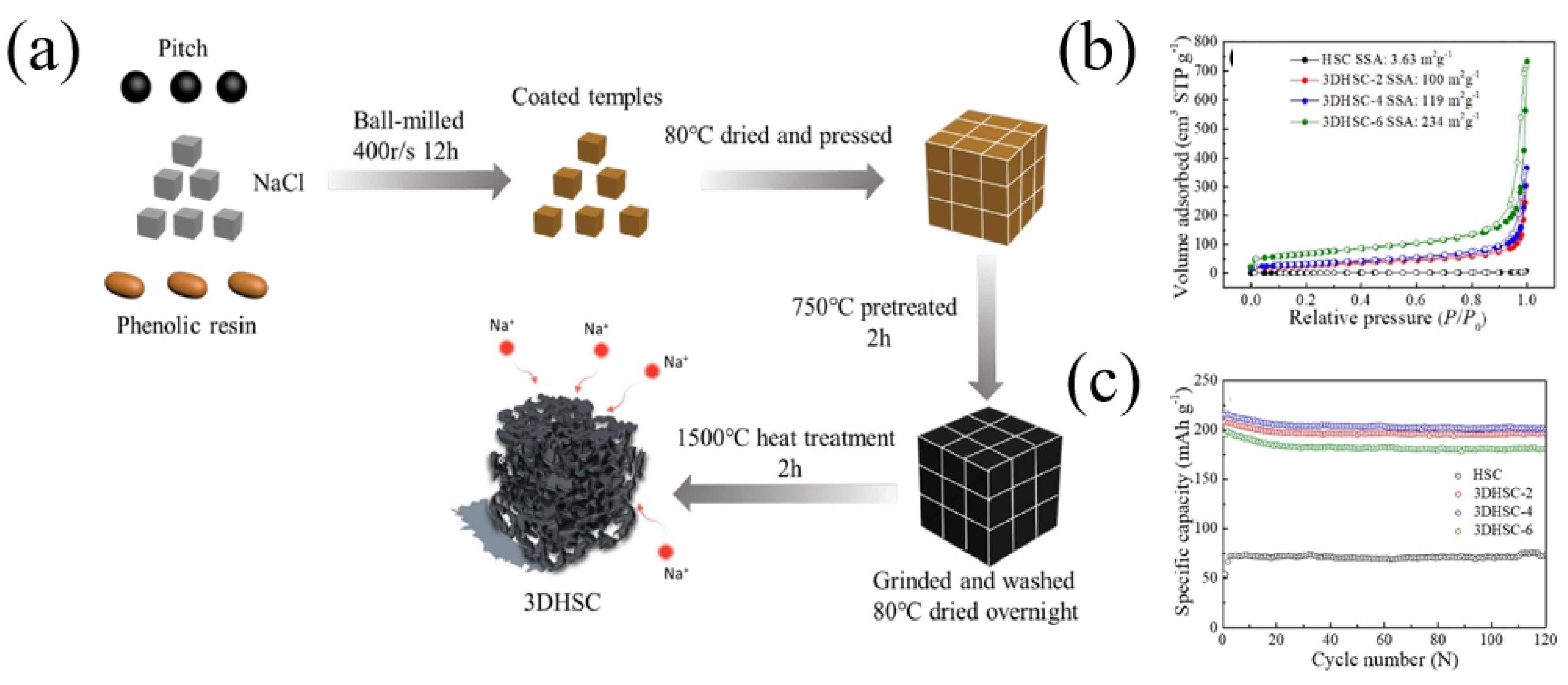
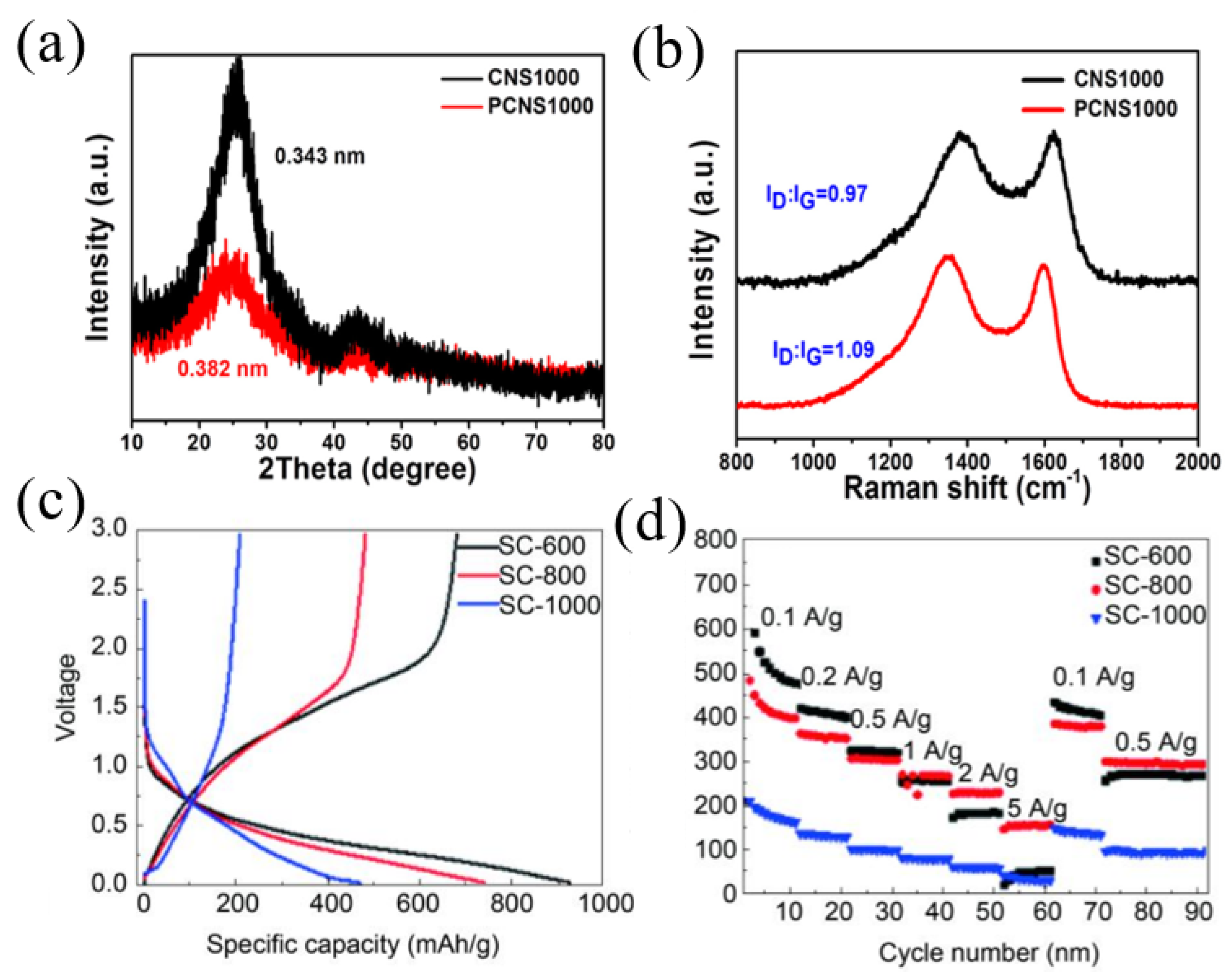
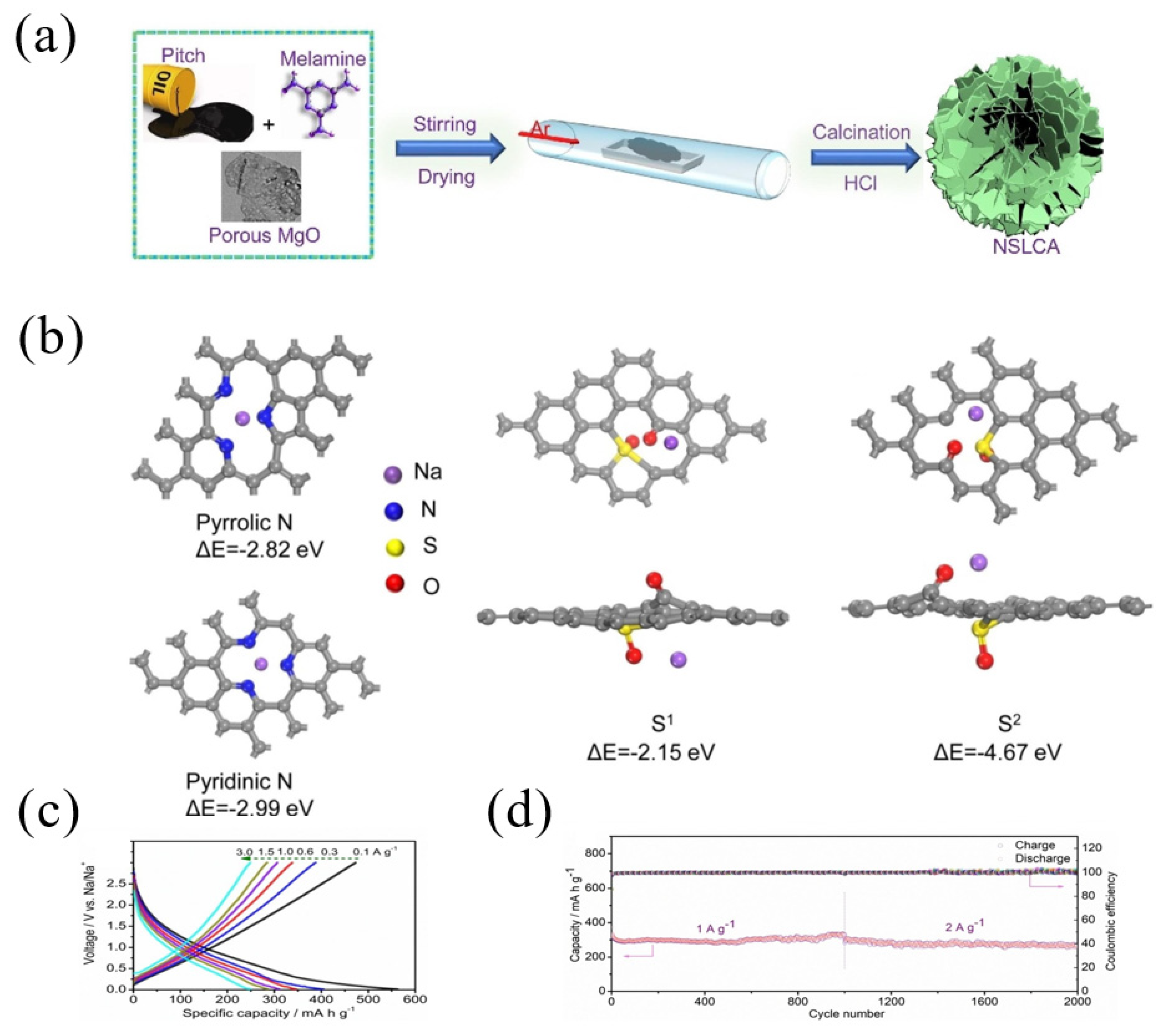
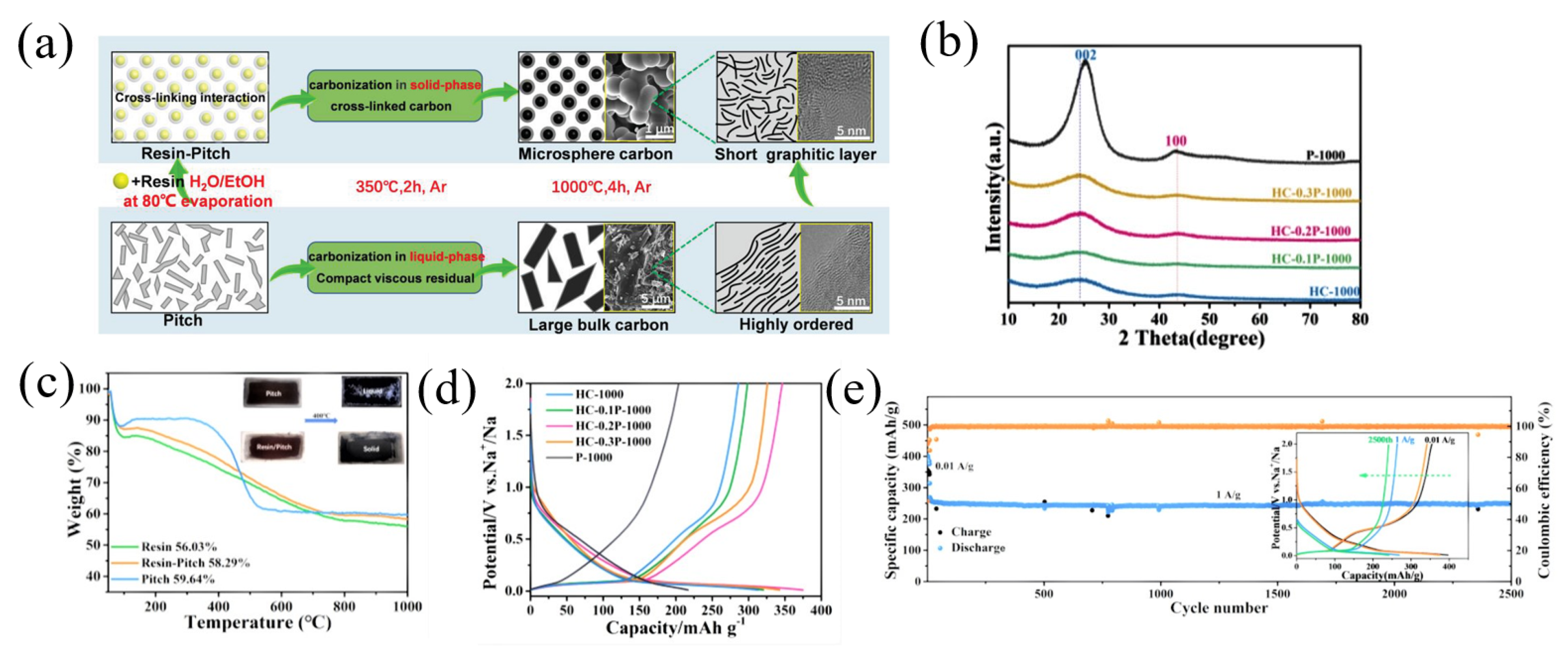
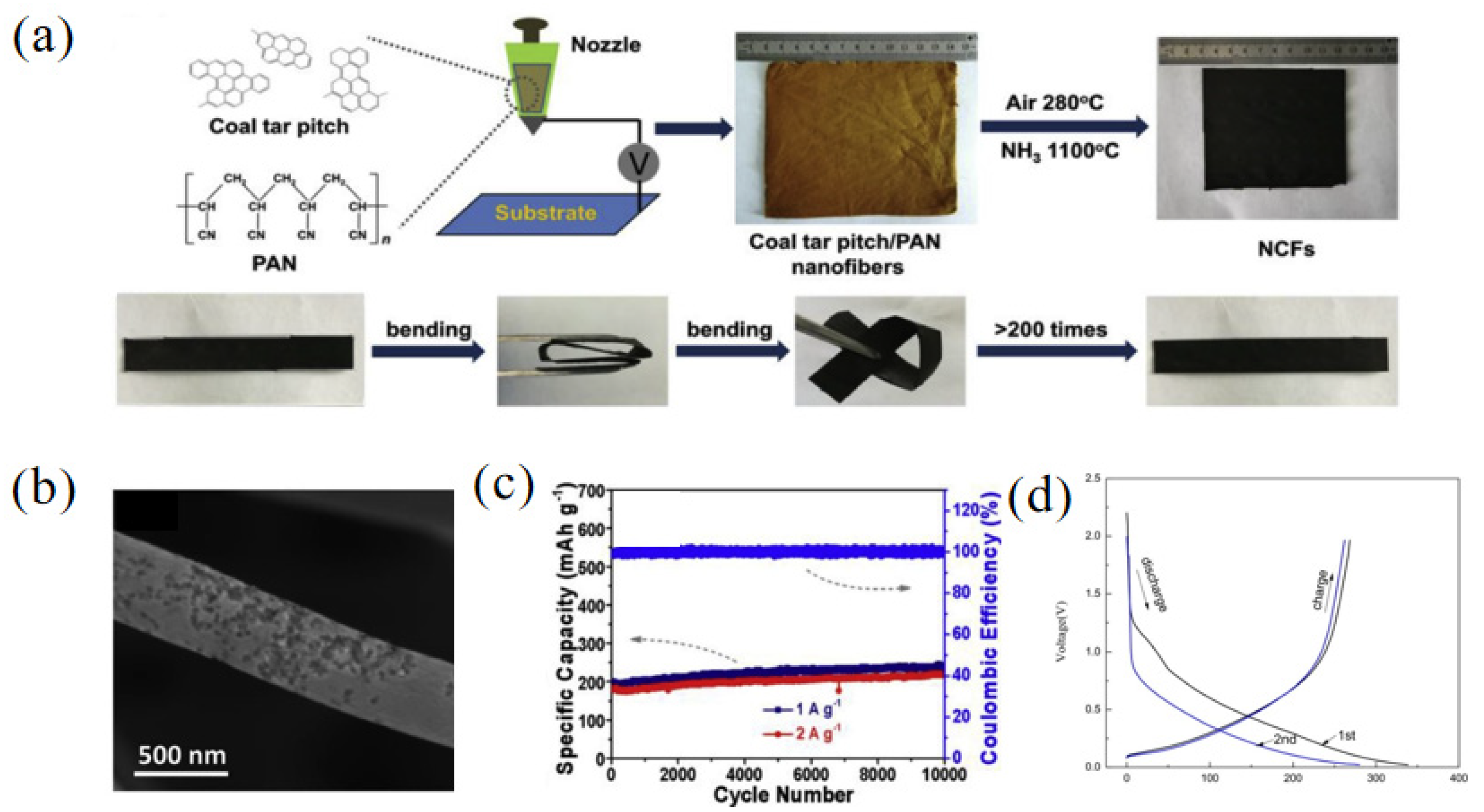
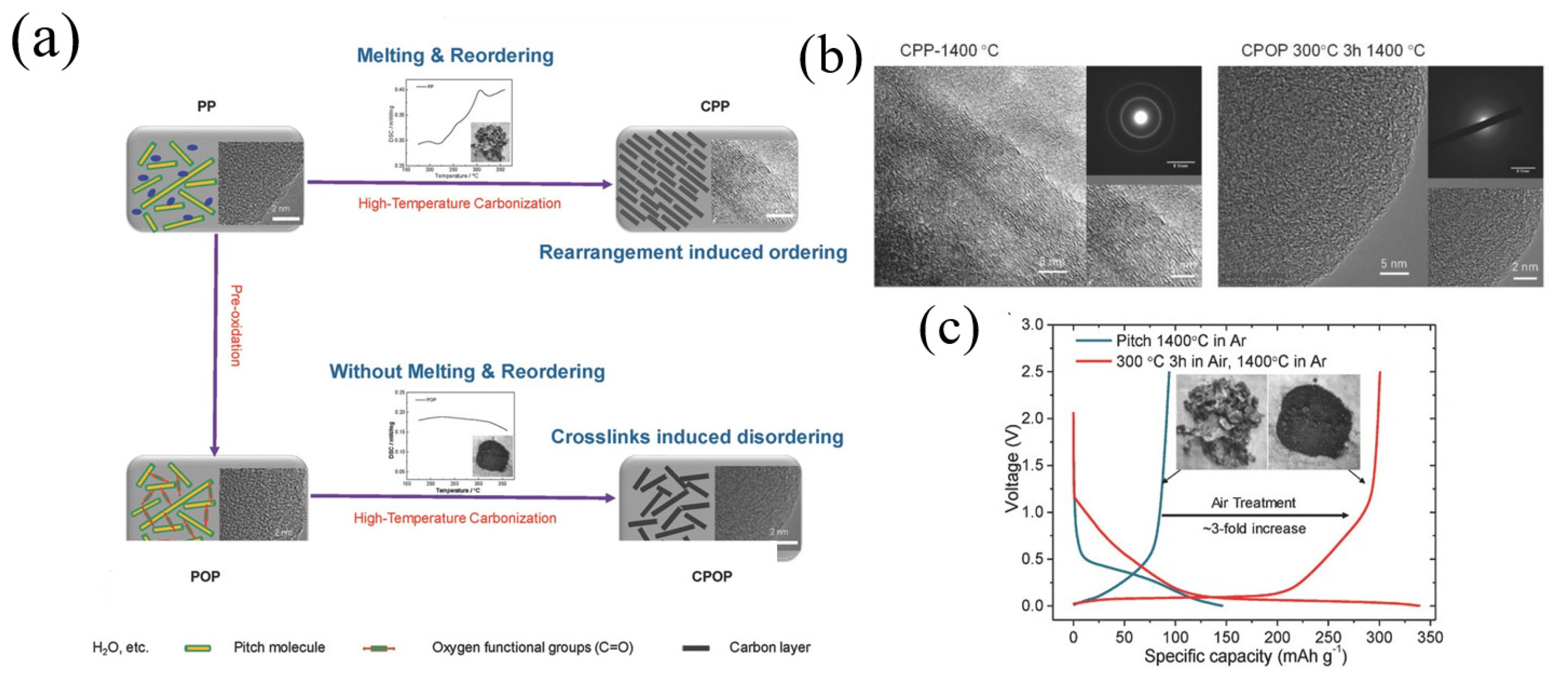
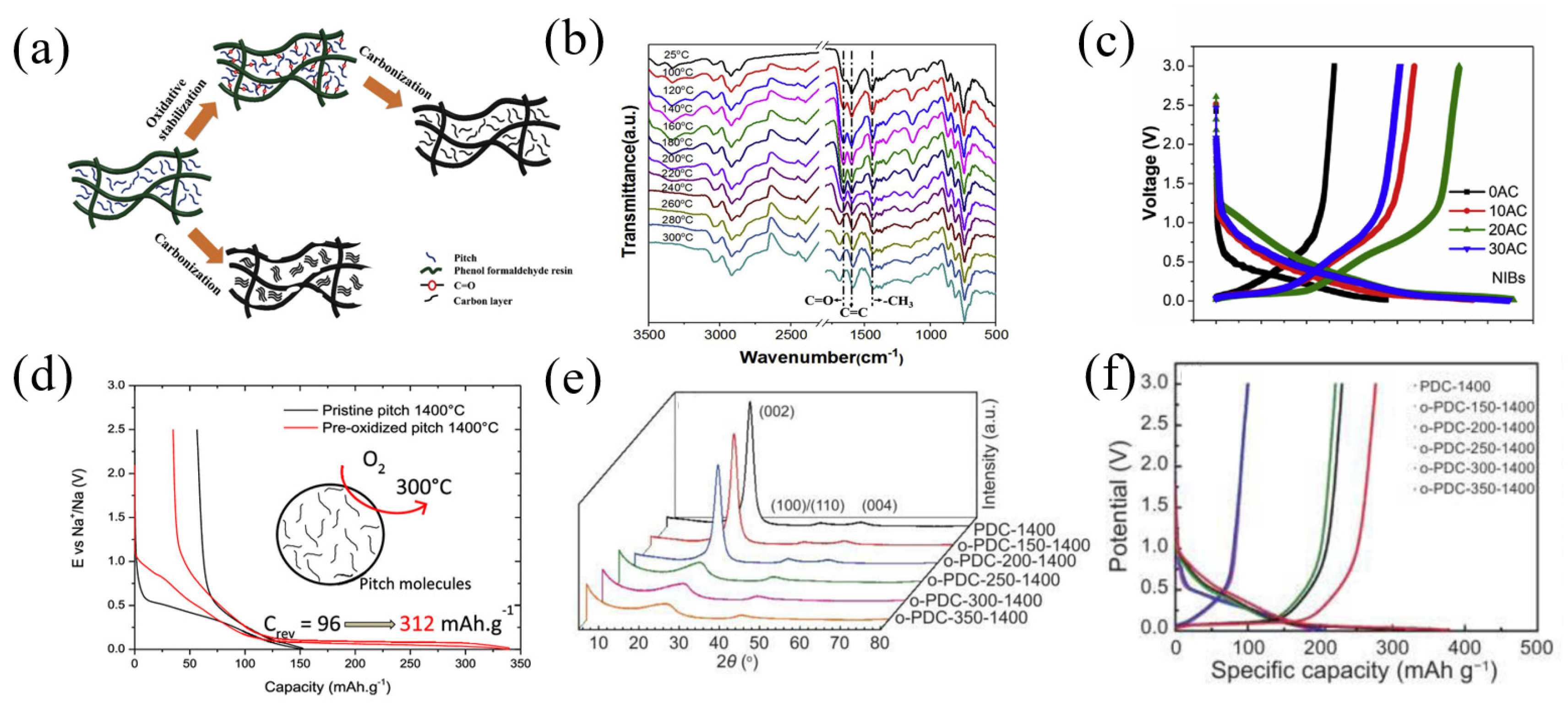
| Modification Strategy | Materials | Reversible Capacity | ICE | Cycle | Ref. |
|---|---|---|---|---|---|
| Porous structure adjustment | MSC | 331 mAh g−1 at | 45% | 103 mAh g−1 after 3000 | [31] |
| 30mA g−1 | cycles at 50 mA g−1 | ||||
| Porous structure adjustment | 3DAC | 280.1 mAh g−1 at | 75% | 188 mAh g−1 after 600 | [32] |
| 30 mA g−1 | cycles at 0.3 A g−1 | ||||
| Porous structure adjustment | 3DHSC-4 | 215 mAh g−1 at | 60% | 200.7 mAh g−1 after 120 | [33] |
| 50 mA g−1 | cycles at 50 mA g−1 | ||||
| N-doped | PCNS1000 | 302 mAh g−1 at | 66% | 176 mAh g−1 after 1000 | [41] |
| 0.1 A g−1 | cycles at 0.5 A g−1 | ||||
| N-doped | PMC-2 | 342 mAh g−1 at | 84% | 111 mAh g−1 after 1000 | [42] |
| 37.2 mA g−1 | cycles at 3 A g−1 | ||||
| S-doped | SC800 | 482.8 mAh g−1 at | 65.2% | 103.7 mAh g−1 after 1000 | [7] |
| 0.1 A g−1 | cycles at 5 A g−1 | ||||
| P-doped | PSC | 251 mAh g−1 at | - | 201 mAh g−1 after 200 | [48] |
| 0.1 A g−1 | cycles at 0.1 A g−1 | ||||
| N, P co-doped | NPSC4-700 | 293 mAh g−1 at | 35.45% | 162 mAh g−1 after 3000 | [50] |
| 50 mA g−1 | cycles at 1 A g−1 | ||||
| N, S co-doped | NSLCA | 500 mAh g−1 at | - | 270 mAh g−1 after 2000 | [51] |
| 0.1 A g−1 | cycles at 2 A g−1 | ||||
| Co-carbonization | HC-0.2P-1000 | 349.9 mAh g−1 at | 60.9% | 249.3 mAh g−1 after 2500 | [57] |
| 50 mA g−1 | cycles at 1 A g−1 | ||||
| Co-carbonization | NCFs | 345 mAh g−1 at | 53.4% | 217 mAh g−1 after 10,000 | [58] |
| 0.1 A g−1 | cycles at 2 A g−1 | ||||
| Co-carbonization | RGO/C800 | 268.4 mAh g−1 at | 79.2% | 239 mAh g−1 after 50 | [59] |
| 20 mA g−1 | cycles at 20 mA g−1 | ||||
| Pre-oxidation | CPP1400 °C | 300.6 mAh g−1 at | 88.6% | 279.4 mAh g−1 after 200 | [64] |
| 30 mA g−1 | cycles at 30 mA g−1 | ||||
| Pre-oxidation | 20AC | 268.3 mAh g−1 at | 82% | 190 mAh g−1 after 200 | [65] |
| 30 mA g−1 | cycles at 0.3 A g−1 | ||||
| Pre-oxidation | HCPOP-ox12 | 312 mAh g−1 at | 86% | - | [17] |
| 96 mA g−1 | |||||
| Pre-oxidation | o-PDC-350-1400 | 276.8 mAh g−1 at | 73.38% | 170.2 mAh g−1 after 200 | [66] |
| 0.1 A g−1 | cycles at 30 mA g−1 |
Disclaimer/Publisher’s Note: The statements, opinions and data contained in all publications are solely those of the individual author(s) and contributor(s) and not of MDPI and/or the editor(s). MDPI and/or the editor(s) disclaim responsibility for any injury to people or property resulting from any ideas, methods, instructions or products referred to in the content. |
© 2023 by the authors. Licensee MDPI, Basel, Switzerland. This article is an open access article distributed under the terms and conditions of the Creative Commons Attribution (CC BY) license (https://creativecommons.org/licenses/by/4.0/).
Share and Cite
Du, W.-S.; Sun, C.; Sun, Q. The Recent Progress of Pitch Nanoengineering to Obtain the Carbon Anode for High-Performance Sodium Ion Batteries. Materials 2023, 16, 4871. https://doi.org/10.3390/ma16134871
Du W-S, Sun C, Sun Q. The Recent Progress of Pitch Nanoengineering to Obtain the Carbon Anode for High-Performance Sodium Ion Batteries. Materials. 2023; 16(13):4871. https://doi.org/10.3390/ma16134871
Chicago/Turabian StyleDu, Wen-Sheng, Chen Sun, and Qiang Sun. 2023. "The Recent Progress of Pitch Nanoengineering to Obtain the Carbon Anode for High-Performance Sodium Ion Batteries" Materials 16, no. 13: 4871. https://doi.org/10.3390/ma16134871
APA StyleDu, W.-S., Sun, C., & Sun, Q. (2023). The Recent Progress of Pitch Nanoengineering to Obtain the Carbon Anode for High-Performance Sodium Ion Batteries. Materials, 16(13), 4871. https://doi.org/10.3390/ma16134871






